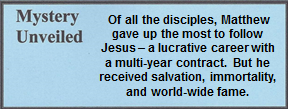06.03.10 Mk. 2:6-12 (See also Mt. 9:3-8; Lk. 5:21-26) Capernaum
SCRIBES QUESTION AUTHORITY OF JESUS
6 But some of the scribes were sitting there, thinking to themselves: 7 “Why does He speak like this? He’s blaspheming! Who can forgive sins but God alone?”
8 Right away Jesus understood in His spirit that they were thinking like this within themselves and said to them, “Why are you thinking these things in your hearts? 9 Which is easier: to say to the paralytic, ‘Your sins are forgiven,’ or to say, ‘Get up, pick up your mat, and walk’? 10 But so you may know that the Son of Man has authority on earth to forgive sins,” He told the paralytic, 11 “I tell you: get up, pick up your mat, and go home.”
12 Immediately he got up, picked up the mat, and went out in front of everyone. As a result, they were all astounded and gave glory to God, saying, “We have never seen anything like this!”
There are several interesting observations to be made in this passage that are also recognizable elsewhere.
- Jesus correctly diagnosed the paralytic’s condition,
- He forgave his sins, and
- He exercised the gift of discernment as to the evil thoughts of His critics.
It is interesting that Jesus replied to their thoughts with questions. Evidently, they were so angry at Him that they did not question how He was able to know their thoughts. On occasion, it might have been possible to correctly guess what they were thinking. Jesus, however, used this gift often with perfect accuracy. That alone should have made them realize His divine nature, not to mention that He healed the paralytic which was a miracle they had never seen. But the real issue in this discourse was the question of who can forgive sins. Irenaeus answered the question with another question:
How can sins be rightly remitted unless the very One against whom one has sinned grants the pardon?
Irenaeus, Against Heresies 5.17
“He’s blaspheming!” Blaspheming (Gk. blasphemia 987) is the act of insulting the honor of God or using reviling and abusive language towards Him,[1] the penalty for which the offender was to be killed by stoning.[2] Likewise, those who insult the proclaimers of God’s Word are also guilty of blasphemy,[3] because they insult the agents of God and, therefore, God Himself.[4] Conversely, those who bless the messengers are blessed because they bless God. The Pharisees refused to believe the divinity of Jesus or that He could forgive sins. Because this was beyond their reasoning, by deliberate decision or lack of comprehension, they concluded that He was blaspheming.
Anyone who insults God or the Holy Spirit is in danger of eternal damnation, and for that there is no forgiveness or relief (Mt. 12:32; Mk. 3:29). However, if someone is concerned about having committed this unpardonable sin, that concern, is self-evident that the unpardonable sin was not committed. Otherwise, there would be no concern for repentance.
“Who can forgive sins but God alone?” This question should have made them realize the deity of Jesus, but it also implied the unspoken charge of blasphemy. It has the exact counter charge of John 5:18 where they considered killing Jesus.[5] By obeying Jesus, the paralytic demonstrated at this point that he had faith in Jesus to heal. Jesus, in turn, said, “Your sins are forgiven.” Again, the concepts of healing and forgiveness of sin are related because the ancients believed that illness was the result of sin in one’s life. Jesus claimed to have the authority to forgive sin, authority that was reserved for God alone. The miracle proved He was not an imposter.
“Which is easier: to say to the paralytic, ‘Your sins are forgiven,’ or to say, ‘Get up, pick up your mat, and walk’?” In this question, Jesus offered a choice of answers to His critics. In true Jewish style, He offered the easier question first and the more difficult second. In Jewish logic, if one could answer the difficult question, then he could obviously respond to the easier one. Anyone could say that sins were forgiven because there would be no physical evidence. However, to tell a paralyzed man to get up and go home with his mat would first require a profound healing, a demonstration of answering the more difficult question. Therefore, by healing the man, Jesus likewise demonstrated He could forgive sin. From this point on, the Jewish leaders challenged Him continuously.
More importantly, the ability to forgive sins pointed directly to His deity. That was a major challenge for the Jews. They believed that man could not be a god or God. The horrific memories of Antiochus, who claimed to be a god was fresh in their minds. Everything Jesus said and did pointed to Himself as the Messiah, but usually did so indirectly.
[1]. Herbert, “Blaspheme.” 32-33; Barclay, A New Testament Wordbook. 51.
[2]. Lev. 24:10-33; 1 Kg. 21:9-14; Acts 6:11, 7:58.
[3]. Archer, “Crimes and Punishment.” 1:1031-32.
[4]. Mt. 10:40; Lk. 10:16; 1 Cor. 12:3; Jas 2:7; 1 Tim. 1-13.
[5]. Edersheim, The Life and Times of Jesus the Messiah. 345.
